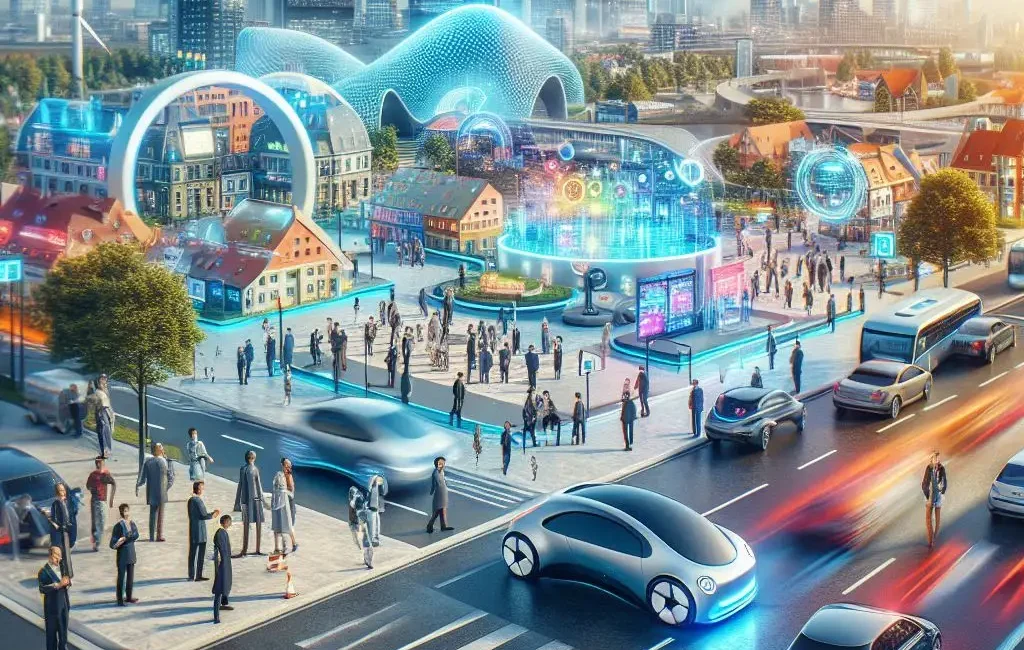
Germany is embarking on a groundbreaking odyssey—driven by electric vehicles (EVs), supercomputing, and artificial intelligence. At the core of this aspiration lies the ambitious partnership between NVIDIA and Deutsche Telekom, which is setting up Europe’s inaugural industrial AI cloud in Germany. Equipped with 10,000 state-of-the-art GPUs and NVIDIA’s DRIVE suite for automotive computing, this venture is steering the nation’s automotive sector towards a future that is both electrified and intelligent. Here’s how this electric beast is being crafted.
1. Germany’s AI Cloud Vision: A Pivotal Leap
In June 2025, NVIDIA and Deutsche Telekom announced their intentions for a vast industrial AI cloud in Germany, expected to launch by 2026—with 10,000 NVIDIA GPUs deployed through DGX B200 systems and RTX PRO servers.
This establishment is touted as Germany’s most extensive AI initiative, designed to cultivate “simulation-first, AI-driven manufacturing” across the automotive industry and beyond.
Utilizing NVIDIA’s Omniverse Blueprint, the AI facility aids in the creation of digital twins, high-fidelity simulations, and robotics logistics planning through CUDA-X libraries and premier industrial software platforms like Siemens, Ansys, and Cadence.
Importantly, the cloud is meant not solely for automotive titans but also for Germany’s Mittelstand—its network of SMEs—granting wider access to advanced computational instruments and AI assets.
2. Merging Electrification with AI: Automakers On Board
Key German automakers, including BMW Group, Mercedes-Benz, Schaeffler, and Maserati, have already woven NVIDIA-supported AI tools into their workflows. BMW noted a 30-fold acceleration in aerodynamics simulations using Omniverse and CAD software, while Volvo enhanced fluid simulations for its EX90 EV by 2.5 times thanks to Blackwell GPUs.
Mercedes-Benz is leveraging NVIDIA’s DRIVE and Omniverse platforms to craft digital twins of factories and refine assembly line automation with AI. These tools help revolutionize EV manufacturing—from design and logistics to robotics and predictive upkeep—into a data-centric operation.
3. DRIVE Platforms Fueling the Electric Vehicle Surge
As the AI cloud drives backend advancements, NVIDIA’s DRIVE AGX Thor and DRIVE Orin platforms infuse AI into the EV cabin and chassis. DRIVE Orin, with a capability of 254 TOPS (trillions of operations per second), facilitates advanced driver-assistance systems (ADAS) and allows for over-the-air software updates to improve features continuously.
DRIVE Thor, based on NVIDIA’s Blackwell architecture, achieves up to 1000 TOPS, providing high-performance inference and sensor fusion for next-gen EVs—such as Level 4 autonomous vehicles—while unifying processing for both driving and cabin AI functions.
Volvo’s forthcoming ES90 sedan, for instance, will incorporate dual DRIVE AGX Orin systems, enabling 508 trillion operations per second for heightened safety, sensor management, and battery optimization—an eightfold advancement compared to earlier models.
Together, the AI cloud and DRIVE hardware constitute a comprehensive strategy: backend computing facilitates rapid development of vehicle software simulations, while in-cabin AI offers intelligent, adaptive experiences on the road.
4. Democratizing AI: Connecting Startups, SMEs, and Academia
Beyond automakers, the initiative broadens AI accessibility to around 900 German startups in NVIDIA’s Inception program, in addition to academic institutions and leading industrial automation companies.
NVIDIA’s Deep Learning Institute, coupled with initiatives like appliedAI, provides upskilling and education in AI to Friedrich-Alexander University and more—enhancing Germany’s AI competencies across its society and preparing the workforce to handle future AI-empowered energy-fueled mobility systems.
5. Strategic Objectives: Sovereign AI & National Competitiveness
At the Paris VivaTech conference, NVIDIA CEO Jensen Huang asserted that AI serves as a significant equalizer—asserting that Europe’s cautious regulatory approach should not hinder its leadership. He articulated the notion of “sovereign AI,” founded on European ethics and data control, cautioning that a failure to invest rapidly could permit the U.S. and China to overshadow the domain.
Germany’s AI cloud is pivotal to this vision: positioning critical industries and supply chains within a framework governed by European standards—part of broader EU endeavors to establish a 100,000-GPU AI gigafactory by 2027.
6. The Electric Vehicle Boom in Germany
Germany stands as one of Europe’s largest markets for electric vehicles. As of 2021, there were over a million registered plug-in electric cars, with annual registrations exceeding approximately 26% market share and yearly sales approaching 680,000 units.
Public confidence in EVs is increasingly rising as the charging infrastructure grows, alleviating range anxiety and enhancing consumer trust.
The AI cloud and DRIVE platforms not only promise accelerated R&D cycles for EVs but also provide advanced AI enhancements such as predictive maintenance, route optimization, and autonomous functionalities—making the transition to electrification smarter, safer, and more flexible.
7. Challenges on the Horizon and Path Forward
Creating such an extensive infrastructure involves challenges: capital-intensive investments, elevated operational expenses, and regulatory oversight surrounding data privacy and AI safety protocols.
Germany must also guarantee that the adoption of AI does not aggravate inequalities—safeguarding smaller enterprises from being eclipsed by larger corporations—and protect against the misuse of advanced simulation technologies or autonomous systems.
The timeline targets launching the AI factory by 2026, with plans for expansion to the EU-wide AI gigafactory initiative by 2027.
8. A Vision Realized: Towards an Electrified, Smart Mobility Ecosystem
Essentially, Germany’s AI strategy is crafting an electric horse—a system characterized by:
– AI-driven simulation-first vehicle design and production
– State-of-the-art in-vehicle computing via NVIDIA DRIVE for EV autonomy and passenger intelligence
– Accessible AI for SMEs and the industrial sector through an infrastructure-focused initiative
– Sovereign, European-controlled technology that enhances global competitiveness.
With BMW, Mercedes-Benz, Schaeffler, Volvo, and hundreds of startups already engaged, the groundwork is laid. Germany’s industrial core is being reconfigured for agility, innovation, and electrification. Future EVs produced in this transformed era won’t just be electric—they will be aware, adaptive, and shaped by intelligence as much as by metal and batteries.